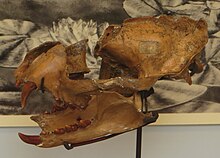
Felidae is the family of mammals in the order Carnivora colloquially referred to as cats. A member of this family is also called a felid. The term "cat" refers both to felids in general and specifically to the domestic cat.

Pseudaelurus is a prehistoric cat that lived in Europe, Asia and North America in the Miocene between approximately twenty and eight million years ago. It is considered to be a paraphyletic grade ancestral to living felines and pantherines as well as the extinct machairodonts (saber-tooths), and is a successor to Proailurus. It originated from Eurasia and was the first cat to reach North America, when it entered the continent at about 18.5 Ma ending a 'cat-gap' of 7 million years. The slender proportions of the animal, together with its short, viverrid-like legs, suggest that it may have been an agile climber of trees.

Nimravidae is an extinct family of carnivorans, sometimes known as false saber-toothed cats, whose fossils are found in North America and Eurasia. Not considered to belong to the true cats, the nimravids are generally considered closely related and classified as a distinct family in the suborder Feliformia. Fossils have been dated from the Middle Eocene through the Late Miocene epochs, spanning about 33.2 million years.
Metailurini is an extinct taxonomic tribe of large saber-toothed cats that lived in Africa, Asia, Europe, and North America from the Miocene to the Pleistocene.

Barbourofelidae is an extinct family of carnivorans of the suborder Feliformia, sometimes known as false saber-toothed cats, that lived in North America, Eurasia and Africa during the Miocene epoch and existed for about 7.9 million years. Thought to be an independent lineage from the Nimravidae and Machairodontinae, which had all attained elongated canines, recent research argues that it may be a subfamily of the Nimravidae, extending its biochronological range into the Miocene, although this issue is not yet fully resolved.

Feliformia is a suborder within the order Carnivora consisting of "cat-like" carnivorans, including cats, hyenas, mongooses, viverrids, and related taxa. Feliformia stands in contrast to the other suborder of Carnivora, Caniformia.

Nimravides is a genus of extinct saber-toothed cats that lived in North America during the Late Miocene, between 10.3 and 5.332 Ma. Despite its scientific name, Nimravides does not belong to the Nimravidae, but is a true cat belonging to the family Felidae.

Stenoplesictidae is the name of a polyphyletic family of extinct civet-like feliforms.

Sansanosmilus is an extinct genus of carnivorous mammal of the family Barbourofelidae endemic to Europe, which lived during the Miocene, 13.65—9.7 mya, existing for approximately 3.95 million years.
Pratifelis is an extinct genus of feline that lived in North America during the middle Miocene period. It contains a single species, Pratifelis martini.

Asiavorator is an extinct genus of civet-like carnivoran belonging in the family Stenoplesictidae. It was endemic to Asia and lived during the Eocene and Oligocene epochs.

Stenoplesictis is an extinct genus of carnivorous cat-like mammals belonging to the superfamily Aeluroidea, from Europe and Asia (Mongolia), from the Oligocene 33.9—28.4 Ma, existing for about 5.5 million years.

Amphicynodontidae is a probable clade of extinct arctoids. While some researchers consider this group to be an extinct subfamily of bears, a variety of morphological evidence links amphicynodontines with pinnipeds, as the group were semi-aquatic otter-like mammals. In addition to the support of the pinniped–amphicynodontine clade, other morphological and some molecular analyses support bears being the closest living relatives to pinnipeds. According to McKenna and Bell (1997) Amphicynodontinae are classified as stem-pinnipeds in the superfamily Phocoidea. Fossils of these mammals have been found in Europe, North America and Asia. Amphicynodontines should not be confused with Amphicyonids (bear-dogs), a separate family of Carnivora which is a sister clade to arctoids within the caniforms, but which may be listed as a clade of extinct arctoids in older publications.
Styriofelis is an extinct genus of Felidae known from the Miocene of Europe.
Hyperailurictis is an extinct genus of felid from Miocene North America. The Hyperailurictis species are Pseudaelurus-grade felids and thought to be the first felids in the Americas.

Leptofelis is an extinct genus of Pseudaelurus-grade felid found in Spain.
Miopanthera is an extinct genus of Pseudaelurus-grade felids.
Sivaelurus is a fossil genus of felid containing only a single species, S. chinjiensis, which was described based on a partial right maxilla collected from the Chinji Formation in the Lower Siwaliks. The species was originally described by Guy Ellcock Pilgrim as Pseudaelurus chinjiensis in 1910, who later erected a new genus, Sivaelurus, for it in 1913.
Asilifelis is an extinct genus of small felid that lived in what is now Kenya during the Early Miocene. Despite its fragmentary remains, it is remarkable because of its small size and advanced dentition. It contains a single species, Asilifelis cotae.
Vishnufelis is a fossil genus of feline (cat) containing only a single species, Vishnufelis laticeps. It was described by Guy Ellcock Pilgrim in 1932, based on the first cranial material of a cat found in Asia: a fragmented skull found in the Chinji Formation, which dates back to the middle Miocene.












